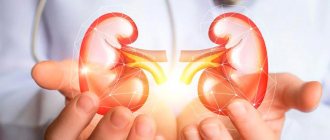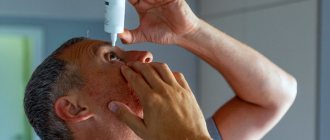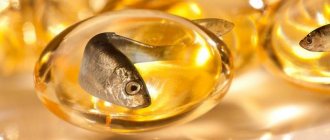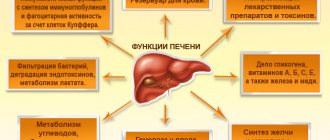Medicinal properties and effects on the body
Milk thistle contains a number of active components that determine its healing effect:
- silymarin – a combination of 4 flavonolignans;
- flavonoids;
- alkaloids;
- saponins;
- vitamins A, D, E, K;
- resins;
- tannins;
- tyramine;
- trace elements (potassium, calcium, boron, magnesium, zinc, selenium, manganese).
— 42%
Natrol, Milk Thistle, 525 mg, 60 Capsules
★★★★★
806 rub. 466 rub.
More details
Let's focus on the main ones:
- Silymarin. Officially recognized as a drug with a powerful hepatoprotective effect. The substance converts free radicals into an inactive form, thereby protecting cell membranes from damage, increasing the flow of bile, and also stimulating the regeneration of liver cells. By normalizing the structure of hepatocytes and slowing the progression of fibrosis, all functions of the organ are improved, especially detoxification and protein synthesis. Silymarin also prevents the reproduction of the hepatitis C virus and reduces the likelihood of developing hepatocellular cancer.
- Fat-soluble vitamins A and E. Protect cells from damage, preventing the development of cancer. They also improve the condition of the skin, hair, nails, and have a positive effect on the visual apparatus and nervous system.
- Cholecalciferol. Promotes the absorption of calcium, strengthens the immune system.
- Vitamin K. Normalizes blood clotting ability.
- Microelements. They are participants in the most important biochemical reactions in the body: they regulate the synthesis of certain hormones, the transmission of nerve impulses, the activity of immune cells, reproductive function, and produce an anti-inflammatory effect.
More details about the medicinal properties of milk thistle can be found in the video:
Milk thistle - medicinal properties and contraindications
Milk thistle flavonoids in the treatment of liver diseases
P
It is difficult to classify milk thistle preparations into any specific group of medicines.
When talking about milk thistle, they often say that it has “hepatoprotective” properties.
However, the legitimacy of identifying a separate pharmacological class of “hepatoprotectors” is questionable. The very concept of “hepatoprotectors” is, by definition, not strict and is interpreted quite arbitrarily by different specialists. In the most common understanding, this is a class of drugs that, regardless of the mechanism of action, increase the functional ability of liver cells to synthesize, detoxify and excrete various biological products, and support the resistance of hepatocytes to various pathogenic influences.
The general nature of the name “hepatoprotectors” apparently reflects the insufficient depth of our knowledge about the pathogenesis of liver diseases, the mechanisms of damage, regeneration, fibrosis and malignant transformation of hepatocytes.
In many reference books and manuals, the class of “hepatoprotectors” includes activators of protein synthesis (bemitil), vitamins, nucleic acid precursors, drugs that stimulate detoxification reactions in the liver (asparagine, glutamine, citrulline), metabolites of mitochondrial respiration (malic acid, sodium succinate, cytochrome , carnitine, aminalon), drugs that reduce the proapoptotic effect of bile acids (ursodeoxycholic acid), sulfhydryl group donors (S-adenosyl-L-methionine), drugs of essential phospholipids, lipoic acid.
At the same time, it is appropriate to recall that a number of drugs of this type (mainly of plant origin) have historically firmly taken their place in the therapy of internal diseases.
Among the “hepatoprotectors”, a very significant share is occupied by preparations containing natural or semi-synthetic flavonoids of milk thistle (Silybum marianum)
. The main active ingredient in them is silymarin.
Silymarin is a mixture of three main isomeric compounds - silicristin, silydianin and silibinin. The latter prevails in quantitative content and has the highest biological activity.
Are milk thistle preparations really capable of having a therapeutic effect on liver diseases?
The positive effects of silymarin in liver diseases are traditionally associated with a pronounced antioxidant potential, as well as the so-called “membrane stabilizing” effect.
The role of oxidative stress in the pathogenesis of liver diseases has been intensively studied in recent years. The production of reactive oxygen species (peroxides, superoxide anion radicals) is a common phenomenon in the process of cellular respiration, but their content increases excessively under conditions of alcohol intoxication, liver damage and inflammation, deficiency of antioxidants, hypoxia, and exposure to certain drugs. Increased production of free radicals is accompanied by damage to cellular organelles and macromolecules (DNA, proteins and lipids, antioxidant systems). Under oxidative stress, peroxidation products play an important role in fibrogenesis by activating hepatic stellate cells and increasing extracellular matrix production.
Intracellular “protective molecules” that prevent the development of peroxidation reactions include enzymes superoxide dismutase, catalase, glutathione peroxidase, metal-binding proteins, “free radical scavenger” molecules (glutathione, ubiquinones, uric acid, ascorbic acid and tocopherol, lipoic acid, selenium, riboflavin , zinc, carotenoids). The metabolism of various antioxidants is closely interrelated.
In conditions of liver inflammation, the source of production of reactive oxygen species is the cells of the inflammatory infiltrate.
In addition, one of the universal mechanisms of cell damage in liver diseases is impaired mitochondrial function.
When a cell is exposed to certain substances, such as tumor necrosis factor-a (TNFa), ethanol, as well as under conditions of excessive accumulation of iron and copper, the process of oxidative phosphorylation in mitochondria is disrupted, which is accompanied by the development of energy deficiency and cell death.
Disorganization of mitochondrial membranes under conditions of peroxidation may be accompanied by a “leakage” of cytochrome C into the cytoplasm and activation of the process of programmed cell death.
Despite the fact that modern scientific data regarding the importance of free radical processes in the pathogenesis of liver diseases are often contradictory, in certain clinical situations the negative pathogenetic role of mitochondrial dysfunction, cellular respiration and the development of lipid peroxidation is beyond doubt. These are primarily alcoholic liver disease, non-alcoholic steatohepatitis, intrahepatic cholestasis of pregnancy, and some cases of toxic liver damage.
The antioxidant effect of silymarin is due to its interaction with free radicals in the liver and converting them into less aggressive compounds. This interrupts the process of lipid peroxidation and prevents further destruction of cellular structures. The ability to interact with reactive oxygen species is due to the presence of a phenolic structure in the silibinin molecule.
The antioxidant effect of silymarin and inhibition of peroxidation reactions have been clearly demonstrated in vitro. Milk thistle flavonoids exhibit 10 times higher antioxidant activity than tocopherol.
Due to the presence of antioxidant properties, milk thistle preparations exhibit anti-inflammatory activity
. The therapeutic effect of silibinin was demonstrated in models of toxic liver damage in rats caused by the administration of carbon tetrachloride. In an acute experiment, with a single administration of carbon tetrachloride, the administration of milk thistle flavonoids was accompanied by a clear decrease in the severity of cytolysis and cholestasis. In a chronic experiment with carbon tetrachloride, the administration of silibinin also contributed to a significant reduction in the severity of cytolysis and cholestasis.
It is no coincidence that workers in hazardous chemical industries are recommended to take prophylactic silymarin once a day.
Milk thistle flavonoids have the most striking therapeutic effect on alcoholic liver disease.
Hungarian researcher Muzes G. et al. in a double-blind study showed that silymarin has a positive clinical effect in alcoholic liver disease
, apparently due to the antioxidant effect of this substance. Prescription of silymarin in a daily dose of 420 mg per day for 6 months. was accompanied by biochemical changes in the body, which indirectly indicate an increase in the antioxidant potential of cells and blood serum. Thus, there was a significant increase in the activity of superoxide dismutase in enterocytes and lymphocytes (with initially reduced values), an increase in the activity of glutathione peroxidase and the content of substances with sulfhydryl groups in the serum. At the same time, there was a significant decrease in the concentration of substances exhibiting oxidizing properties (malondialdehyde, etc.) in the blood serum.
For viral hepatitis C, according to Berkson BM, the administration of a “triple antioxidant regimen” (thioctic acid, silymarin, selenium) is a fairly cheap and safe method of pathogenetic treatment of viral hepatitis C and inhibition of the progression of liver damage to the stage of cirrhosis. The antioxidant effect of therapy helps suppress the inflammatory-necrotic reaction in the liver, inhibit the development of fibrosis and reduce the risk of malignant transformation of hepatocytes.
Also interesting are data on the immunomodulatory properties of milk thistle flavonoids in alcoholic liver disease. Their long-term administration (about 6 months) helps to reduce the activity of the cytotoxic link (the content of cytotoxic CD8+ lymphocytes), reduce the production of g-globulins and increase the rate of blast transformation of lymphocytes.
A number of authors consider it advisable to prescribe silymarin to patients suffering from hepatitis C, if they need to take drugs that can reduce the antioxidant potential of hepatocytes (for example, acetaminophen).
For intrahepatic cholestasis of pregnancy, the use of silymarin can reduce the severity of skin itching.
Silymarin “stabilizes” hepatocyte membranes, reducing the cells’ susceptibility to certain pathogenic influences.
Blockade of phosphodiesterase under the influence of milk thistle flavonoids helps slow down the breakdown of cyclic adenosine monophosphate (cAMP), and, as a result, reduce the calcium content inside cells, inhibiting the calcium-dependent process of activation of phospholipases.
Silibinin has the ability to block the corresponding binding sites on the cell membrane and transport systems that facilitate the transfer of toxic substances across the membrane. This is the main mechanism of the therapeutic effect of silibinin in case of poisoning with toadstool (counteracting the poison a-amantine). To treat patients with such poisonings, a readily soluble form of silibinin for intravenous administration (dihydrosuccinate sodium salt) has been developed.
An important aspect of the metabolic action of milk thistle flavonoids is also the ability to stimulate protein synthesis and support the process of hepatocyte regeneration. Silibinin stimulates RNA polymerase I in the cell nucleus, activates transcription and the rate of RNA synthesis.
At the same time, the rate of DNA transcription in malignant cells, as well as the rate of their division, does not increase, which excludes the possibility of stimulating tumor growth when prescribing milk thistle preparations.
There is evidence of a slowdown in the rate of progression of liver fibrosis during long-term use of silibinin.
Unfortunately, the anti-inflammatory and antifibrotic effects of milk thistle preparations are currently not confirmed by the results of multicenter randomized controlled trials, and the available data are obtained from the results of individual observations. The effectiveness of silymarin should be assessed according to the principles of evidence-based medicine.
It is advisable to prescribe milk thistle derivatives to patients suffering from liver diseases (mostly chronic): hepatic steatosis, acute or chronic hepatitis, cirrhosis of various etiologies. Caution should be exercised when prescribing them to patients with clearly defined intrahepatic cholestasis: there is information about the possibility of increasing bile stagnation under the influence of drugs.
It has been noted that both acute and chronic liver diseases are often accompanied by the development of concomitant biliary dyskinesia. Biliary dyskinesia is the leading cause of pain in the epigastric region and right hypochondrium with steatosis, hepatitis and cirrhosis of the liver, often with characteristic irradiation to the right half of the chest, right shoulder blade and a clear connection with the intake of fatty, fried foods.
The development of biliary tract motility disorders often dictates the need to prescribe to the patient drugs that have a mild antispasmodic effect on the smooth muscle cells of the biliary system.
Silymarin directly has choleretic properties due to the presence of both choleretic and cholekinetic effects. Choleresis develops due to increased secretion of bile acids and electrolytes by hepatocytes. The cholekinetic effect is associated with a decrease in the tone of the biliary sphincters.
However, many of the drugs, the main active ingredient of which are milk thistle flavonoids, contain components of other medicinal plants that have a combined effect on the composition and outflow of bile: moderate choleretic, antispasmodic, anti-inflammatory and antiseptic effects.
The main active ingredient from the family of medicinal flavonoids of milk thistle - silibinin - is included in various drugs: Sibektan, Legalon, Siromin, etc. The differences between these drugs consist in the quantitative ratios of flavonoids, as well as in combinations of milk thistle with other drugs, usually having a choleretic or antiseptic effect.
The drug Sibektan
contains dry extract of tansy, milk thistle fruits, St. John's wort and birch.
St. John's wort herb contains tannins from the catechin group (tannins, flavonoids, essential oils), which have an astringent and anti-inflammatory effect on the mucous membrane of the gastrointestinal tract.
Tansy flowers also contain various flavonoids, essential oils and organic acids, which have a choleretic effect (increase the contractile activity of the gallbladder).
Birch leaf extract also has an antiseptic, mild choleretic and distinct diuretic effect.
Sibektan is successfully used in the treatment of chronic cholecystitis and hypotonic dyskinesia of the gallbladder. It is prescribed for hepatitis and cirrhosis of the liver to prevent the progression of the process.
Considering the presence in the drug of substances with quite pronounced cholekinetic activity that can enhance the motor function of the gallbladder, Sibektan should be prescribed with caution in case of cholelithiasis.
Milk thistle flavonoid preparations are prescribed mainly orally, half an hour before meals. They are quickly and completely absorbed from the gastrointestinal tract. Plasma protein binding is weak. Excreted mainly in bile, to a lesser extent in urine; the half-life is about 6 hours. They are actively included in the enterohepatic circulation, which seems to be an advantageous pharmacokinetic parameter.
The duration of treatment courses is from 25 days to 1.5 months. Repeated courses are possible.
Numerous studies have established that milk thistle preparations belong to the category of low-toxic substances and in therapeutic doses do not have a damaging effect on the main organs and systems of the animal and human body.
When prescribing, the possibility of developing allergic reactions to plant components should be taken into account.
Literature:
1. FARMIndex: PRACTITIONER, issue 3 – St. Petersburg: FARMIndex LLC, 2002 – 136 p.
2. Berkson BM. A conservative triple antioxidant approach to the treatment of hepatitis C. Combination of alpha lipoic acid (thioctic acid), silymarin, and selenium: three case histories. Med Klin 1999 Oct 15;94 Suppl 3:84–9.
3. Deak G, Muzes G, Lang I, et al. Immunomodulator effect of silymarin therapy in chronic alcoholic liver diseases. Orv Hetil 131:1291–1292;1990.
4. Feher J, Deak G, Muzes G, et al. Liver–protective action of silymarin therapy in chronic alcoholic liver diseases. Orv Hetil 130:2723–2727; 1989.
5. Ferenci P, Dragosics B, Dittrich H, Frank H, et al. Randomized controlled trial of silymarin treatment in patients with cirrhosis of the liver. J Hepatol 9:105–113; 1989.
6. Lang I, Nekam K, Deak G, et al. Immunomodulatory and hepatoprotective effects of in vivo treatment with free radical scavengers. Ital J Gastroenterol 22:283–7; 1990.
7. Magliulo E, Gagliardi B, Fiori GP. Results of a double blind study on the effect of silymarin in the treatment of acute viral hepatitis, carried out at two medical centers. Med Klin 73:1060–1065; 1978.
8. Muzes G, Deak G, Lang I, et al. Effect of silimarin (Legalon) therapy on the antioxidant defense mechanism and lipid peroxidation in alcoholic liver disease (double blind protocol). Orv Hetil 131:863–866; 1990.
9. Reyes H, Simon FR. Intrahepatic cholestasis of pregnancy: an estrogen–related disease. Semin Liver Dis 13:289–301; 1993.
10. Salmi HA, Sarna S. Effect of silymarin on chemical, functional, and morphological alterations of the liver. A double–blind controlled study. Scand J Gastroenterol 17:517–521; 1982.
Indications for use
According to the instructions for use, milk thistle oil in capsules is indicated for the following diseases and pathological conditions:
- liver diseases (hepatitis of various etiologies, cirrhosis, alcoholic or non-alcoholic fatty infiltration, cholelithiasis, gallbladder dyskinesia);
- gastritis or stomach ulcer;
- colitis, enterocolitis;
- hypertension;
- atherosclerotic vascular lesions;
- cardiac ischemia;
- diabetes;
- dermatitis;
- deficiency of vitamins A, E.
Silymarin is also used as a hepatoprotector during chemotherapy of malignant tumors. A positive effect has also been recorded in cases of severe toxic liver damage: capsules with milk thistle oil can be taken as an antidote for poisoning caused by toadstool.
Topically milk thistle oil is used in the following areas:
- dentistry (stomatitis, gingivitis);
- otorhinolaryngology (pharyngitis, tonsillitis, rhinitis);
- gynecology (colpitis, erosion, vaginal dryness);
- cosmetology (as a component of nourishing masks).
Jarrow Formulas, Milk Thistle, 150 mg, 100 Vegetarian Capsules
★★★★★
622 rub.
More details
Peculiarities
Milk thistle oil is a unique natural product in its composition. It has a huge range of healing properties. In addition, it is important that the product has a minimum number of contraindications. Milk thistle oil is most often used as a hepaprotective agent. In addition, it strengthens the body’s defenses against various external negative factors.
Milk thistle oil has a yellowish-green hue. The natural product has a pleasant taste and smell. The benefits of milk thistle oil are associated with its rich composition. The product contains flavonoids of the silymarin group. These substances have a beneficial effect on the functioning of the liver, promoting the renewal and restoration of its cells. Silymarin reduces the risk of liver damage from toxic substances.
In addition, milk thistle oil contains all existing fat-soluble vitamins. This:
- Vitamin D, which promotes the absorption of phosphorus and calcium, and also strengthens the immune system.
- Vitamin K, which regulates blood clotting.
- Tocopherols that protect the body from the action of free radicals and support the proper functioning of the reproductive and cardiovascular systems.
- Carotenoids that ensure growth, support vision function and normalize metabolism.
The important components of milk thistle oil are:
- B vitamins. They are involved in many processes in the human body, in particular they contribute to the synthesis of hemoglobin. In addition, these substances normalize the functioning of the nervous system.
- Unsaturated fatty acids. These substances prevent the development of strokes and heart attacks and minimize the risks of atherosclerosis.
Milk thistle oil contains compounds of minerals important for the body, in particular zinc, selenium, magnesium, etc. They are important for the correct functioning of various processes, and maintain internal organs and systems in good condition.
Contraindications and precautions
Absolute contraindications include:
- allergy to the components of the drug;
- acute cholecystitis or pancreatitis;
- clinical depression;
- epilepsy;
- bronchial asthma.
During pregnancy or lactation, capsules can be taken only in consultation with a doctor. The oil also has a laxative effect, so for any diseases associated with diarrhea, milk thistle capsules should be consumed with caution, in small quantities. In case of chronic heart failure or impaired renal function, monitoring of potassium levels in the blood is required.
Caution should also be exercised in the presence of cholelithiasis. Due to the pronounced choleretic effect of silymarin, it is recommended to combine milk thistle with antispasmodics that relax the sphincter of Oddi. This will help prevent the stone from getting stuck in the duct and the development of biliary colic.
Attention! Before starting treatment, it is necessary to perform an ultrasound of the hepatobiliary zone to assess the number and size of stones.
Any choleretic drugs are contraindicated in the presence of single large stones or more than 3 small ones. Sand or echogenic suspension in the gallbladder can be treated and is therefore not a contraindication.
Release forms
Milk thistle capsules may contain extract or oil from the plant's seeds. The main active ingredient of the first is silymarin, it is used to protect or restore the liver.
The oil has a richer composition, including polyunsaturated fatty acids, fat-soluble vitamins, and accordingly has many indications. However, when taking this form of release, side effects are often observed in the form of diarrhea or discomfort in the right hypochondrium, caused by a powerful choleretic effect. Capsules with oil can be consumed only if the function of the pancreas is fully preserved: a deficiency of the lipase produced by it will lead to poor digestibility and steatorrhea.
Instructions for use of capsules with milk thistle extract
Table 1 – Main preparations with milk thistle extract
| Name | Packaging price (from), rub. | Release form | Daily dosage, pcs. |
| Milk thistle extract (Evalar, Russian Federation) | 100 | Pills | 1 (30 mg) |
| Milk thistle-extra (Pharmacor Production, RF) | 180 | Capsules | 1 (220 mg) |
| Milk Thistle (Jarrow Formulas, USA) | 1069 | 1-3 (150-450 mg) | |
| Milk Thistle (Natrol, USA) | 484 | 2 (525 mg) | |
| Silymarin, Milk Thistle Extract (Now Foods, USA) | 588 | 2-6 (300 mg) |
According to the recommendations of gastroenterologists, drugs with silymarin should be taken orally, after meals. Therapeutic dosages are about 500 mg per day, prophylactic dosages are 200-300.
Clinical studies have shown that daily intake of up to 900 mg of the active substance is absolutely safe. When the amount is increased to 1500 mg per day, 2-10% of people may develop side effects.
The course of treatment is at least 3 months.
Experience of using the drug Prostopin in patients with chronic prostatitis with pathospermia
V.V. Evdokimov, M.N. Korshunov, E.S. Korshunova, A.S. Kondratyev, E.I. Dubkov Federal State Institution "Research Institute of Urology" of the Ministry of Health and Social Development of Russia, Moscow
Currently, the share of the male factor in infertile marriages is almost 50%. Numerous studies have shown that recent decades have been marked by a decline in male fertility [2, 9, 20]. The multifactorial nature of this problem has become obvious. First of all, external and internal factors of pathological influence are considered. External influences include: electromagnetic radiation from mobile phones, computers, soil, water, and air pollution. The list of internal factors includes infectious diseases of the reproductive system, trauma to the genital organs, etc. In the last two decades, a number of fundamental and applied works have appeared on the study of the regulation of the functional activity of the male reproductive system [3, 4, 13, 21]. A paradigm of a multi-level reproduction system has been developed, including immune, genetic, hormonal and other components.
The multifactorial pathogenesis of male infertility causes difficulties in diagnosing and treating male infertility. The choice of adequate therapy depends on an accurate understanding of the physiological mechanisms of spermatogenesis disorders [24, 25, 26]. Extensive research is being conducted on the correction of various types of pathospermia using various pharmacological drugs [12].
Chronic prostatitis is one of the most difficult urological diseases to diagnose and treat. A number of researchers believe that in most cases the etiology, pathogenesis and pathophysiology of chronic prostatitis remains unknown [8, 11, 15, 17]. It is still unclear whether the process can be initially abacterial, or whether the disease, having begun as a result of the penetration of infectious agents into the prostate gland, subsequently proceeds without their participation, i.e. passes through infectious and post-infectious phases. Obviously, it is impossible to identify microorganisms cultured from prostate secretions with the etiological factor of the disease, because in most cases this flora is saprophytic. Certainly recognized causes of bacterial inflammation of the prostate gland are E. coli, Proteus, Klebsiella, Pseudomonas. Gram-positive enterococci, intracellular infections (chlamydia, ureaplasma, mycoplasma), tuberculosis seem to many researchers to be dubious pathological agents in the development of chronic prostatitis [7, 21].
The frequency of individual types of prostatitis, according to generalized literature data, is: acute bacterial prostatitis – 5–10%, chronic bacterial prostatitis – 6–10%, chronic abacterial prostatitis – 80–90% [1, 5].
The US National Institutes of Health recognizes that abacterial prostatitis is at least 8 times more common than bacterial prostatitis. According to the WHO, in the United States alone, about 3 million men of working age fall ill with chronic prostatitis every year, and chlamydial infection is detected in 40% of them [23]. The etiological significance of this and other genital tract infections in the development of chronic abacterial prostatitis has not been proven [22].
It should be noted that in patients with chronic abacterial prostatitis, pathospermia of varying severity is often detected [12]. It is known that the development of reproductive function disorders of various origins in men is accompanied by an increased formation of reactive oxygen species [2]. In particular, in chronic inflammatory diseases of the prostate gland, the accumulation of reactive oxygen species occurs with the activation of free radical oxidation of biopolymers, as a consequence, damage to sperm and a subsequent decrease in their functional activity [12].
Increased lipid peroxidation processes against the background of reduced antioxidant protection in the ejaculate is at least one of the reasons for the development of subfertility.
Treatment of pathospermia, regardless of etiological factors, is not always effective, which does not satisfy both parties - the patient and the doctor. In this regard, the search for drugs that affect spermatogenesis is an urgent task.
Since 2002, the drug Prostopin has been produced in Russia and is used in various fields of medicine [6, 10, 14, 16, 18, 19]. Prostopin is a brown rectal suppository with a specific odor of propolis. The drug includes activated propolis (native and extracts), royal jelly, dried bee bread, pollen (pollen), natural honey, beeswax, anhydrous lanolin, cocoa butter. To date, the anti-inflammatory and anti-edematous effect of Prostopin has been established, but its effect on the processes of spermatogenesis, in particular, on the fertile parameters of the ejaculate, has been less studied.
Target
To evaluate the effectiveness of the drug Prostopin for pathospermia in patients with chronic prostatitis.
Materials and methods
A prospective, non-comparative study of the effect of the drug Prostopin on the reproductive function of men suffering from chronic prostatitis was conducted at the advisory clinic of the Federal State Institution "Research Institute of Urology" of the Ministry of Health and Social Development. The patient group consisted of 25 men aged from 20 to 45 years (average age 32.5 years). The clinical diagnosis of chronic abacterial prostatitis was made on the basis of patient complaints (pain in the perineum and urethra, increased urge to urinate, erased orgasm) and a clinical examination, which included ultrasound of the prostate, examination of prostate secretions and ejaculate culture. Ultrasound revealed an increase in the volume of the prostate (on average up to 29.7±6.7 cm3), swelling of the tissue and a change in the echogenicity of the pattern in the gland, which indicated a stagnant process in the organ. An analysis of prostate secretion revealed a slight increase in leukocytes to 10-12 per field of view and a decrease in the number of lecithin grains. Sperm culture did not reveal microflora growth. An analysis of the ejaculate carried out before prescribing a course of therapy revealed a decrease in sperm motility, which was assessed according to WHO standards as asthenozoospermia [23]. All patients were prescribed Prostopin as monotherapy. The course of treatment lasted 1 month, during which each patient received 2 suppositories per day (in the morning and before bedtime).
Results and discussion
At the end of the monthly course of treatment, all patients noted a decrease or disappearance of pain in the perineum; ultrasound revealed a decrease in the volume of the prostate gland on average from 29.7±6.7 to 16.6±4.7 cm3, and a change in ejaculate parameters. The table shows the results of the main fertility parameters. A significant increase in sperm volume, number of live sperm, total and active sperm motility was established. The obtained effect in relation to these parameters of the ejaculate may be due to the biological properties of the drug Prostopin. A decrease in sperm concentration was detected. In our opinion, these changes may be due to increased libido and activation of sexual activity, noted in 18 out of 25 patients. It should be noted that both before and after treatment, sperm concentration did not go beyond the reference values (WHO, 2001). We believe that it is necessary to continue further studies of the properties of Prostopin in a group with a larger number of patients and a longer period of use of the drug.
Table. Main parameters of ejaculate before and after treatment (n=25).
| Index | Before treatment | After treatment | VO standards |
| Ejaculate volume, ml | 3,4±1,2 | 4,2±1,4* | 2-6 |
| Sperm concentration, million/ml | 71,4±33,7 | 60,9±22,5 | more than 20 |
| Live sperm, % | 62, 2±5,9 | 65,9±2,3** | 70 |
| Total sperm motility, % | 31,9±9,6 | 39,4±12,4* | 50 |
| Active sperm motility, % | 12,0±4,9 | 16,3±6,9* | 25 |
| Normal sperm shapes, % | 34,1±10,6 | 39,0±8,2 | 30 |
* - the difference is significant compared with the corresponding indicator before treatment (p <0.05). ** - the difference is significant compared with the corresponding indicator before treatment (p <0.01).
conclusions
Thus, the results obtained indicate that the administration of Prostopin in the form of monotherapy is an effective, safe and affordable method of treating pathospermia in patients with chronic prostatitis. Prostopin helps improve ejaculate parameters, which allows it to be recommended for increasing fertility in pathospermia of various etiologies.
Bibliography
1. Belozerov M.N., Morozova L.V. An integrated approach to the treatment of chronic prostatitis in an outpatient setting. Mater. Congress "Men's Health" M., 2008, 91-92. 2. Bozhedomov V.A. Male immunological infertility. Diss. Doctor of Medical Sciences M., 2001. 3. Bragina E.E., Abdumalikov R.A. Guide to spermatology. M., 2002.
Problems of reproduction, 2005, No. 2, 19-22. 5. Gorilovsky L.M., Zingerenko M.B. Chronic prostatitis. Attending doctor. 2003; 7. 6. Denisov A.K., Kalmykov A.A., Saraf A.S. Prostopin is a modern, highly effective drug for the treatment of acute and chronic urological and proctological diseases of viral-bacterial origin. Difficult patient. 2007; 3:39–41. 7. Ilyin I.I. Nongonococcal urethritis in men. – M., Medicine, 1991. 8. Kogan M.I., Shangichev A.V. Evaluation of treatment of chronic prostatitis in outpatient settings. - Mater. Congress "Men's Health", M., 2008, 91-92. 9. Kulakov V.I. Infertile marriage. Modern approaches to diagnosis and treatment. M. GEOTAR-Media, 2005, 616. 10. Kuchersky V.M., Kalmykov A.A., Dubkov E.I. Modern problems in the treatment of chronic prostatitis. - RMJ. 11. Laurent O.B., Pushkar D.Yu., Segal A.S. Our understanding of prostatitis. - Pharmateka. 2002; 10: 69–75. 12. Lutsky D.L., Polunin A.I. Study of spermoplasm in chronic nonspecific prostatitis and urethritis. – Androl. and genit. surgery, 2002, No. 3, 32 – 33. 13. Nishlag E., Bere G.M. Andrology: men's health and reproductive system dysfunction. M., MIA, 2005, 554. 14. Perepanova T.S., Khazan P.L. Prevention and treatment of infectious and inflammatory complications in a urological clinic. All-Russian scientific and practical conference. M., 2007, 105-106. 15. Perepanova T.S. Modern management of patients with chronic prostatitis. – Effective pharmacotherapy in urology. 2009, No. 2, 2 – 7. 16. Prostopin. - A manual for doctors. M.: 2007: 20. 17. Pushkar D.Yu., Zaitsev A.V., Rasner P.I. Optimization of the algorithm for diagnosis and treatment of chronic bacterial prostatitis. - RMJ. 2008; 16:17:34–38. 18. Saraf A.S., Suvorov A.N. A complex natural preparation in the form of suppositories for the treatment of urological, proctological and gynecological diseases and a method for its preparation. Description of the patent for an invention. 2000. 19. Saraf A.S., Kalmykov A.A., Denisov A.K. On the effectiveness of using the new original domestic drug Prostopin for the treatment of acute and chronic prostatitis and benign prostatic hyperplasia. - Difficult patient. 2007; 12:5–7. 20. Ter-Avanesov G.V. Andrological aspects of infertile marriage. M., 2002. 21. Tiktinsky O.L. Guide to andrology. L., 1990. 22. Tkachuk V.N. Chronic prostatitis. M., 2006. 23. WHO guidelines for laboratory testing of human ejaculate and the interaction of sperm with cervical mucus. 4th ed. M., 2001. 24. Comhaire F, Decleer W. Quantifying the effectiveness and cost-effectiveness of food supplementation with antioxidants for male infertility. Reprod Biomed Online. 2011 May 19. 25. Foster R, DaCosta V, Everett D, Christie L, Harriott J, Wynter S, Frederick J, Walters Y. Successful treatment of severe male factor infertility in Jamaica with intracytoplasmic sperm injection. West Indian Med J 2011 Jan;60(1):41-5. 26. Rozen S. Defending male fertility. Sci Transl Med. 2011 Jul 20;3(92):92ps31.
Topics and tags
Binnopharm
Comments
To post comments you must log in or register
Side effects and allergies
Milk thistle oil is one of the most hypoallergenic drugs, however, in rare cases, it can cause hypersensitivity. If red, itchy rashes appear on the skin, swelling of the eyelids, lips, tongue, or difficulty breathing, you should immediately stop taking the drug and take an antihistamine.
Other side effects include:
- nausea;
- weakness;
- lack of appetite;
- headache;
- bloating;
- discomfort in the right hypochondrium;
- diarrhea.
Reviews about the application
You can write a review and share your opinion about milk thistle treatment in a special form:
| Leave your review | |
| 1 2 3 4 5 | |
| Send Cancel | |
Send your review
Milk thistle capsules
Average rating: Number of reviews: 0
Feedback from customers who have taken milk thistle medications is mostly positive.
Pros:
- effectiveness (decrease in transaminases, bilirubin in the blood, improvement in liver function indicators);
- safety even with long-term treatment.
Minuses:
- the appearance of nausea;
- bitterness in the mouth;
- loosening of stools (for patients with constipation this can be a plus).
Drug interactions
When treated with dosages of less than 1500 mg of silymarin per day, milk thistle does not affect medications and does not lose its properties when interacting with other drugs. But doctors still advise:
- To enhance the effect and prevent dyspepsia in patients with dysfunction of the gallbladder or sphincter of Oddi, it is recommended to combine capsules with oil with papaverine-like antispasmodics. The most successful are combinations with fuming, yarrow, fennel, Mebeverine, Odeston.
- Nutritional supplements combine well with other hepatoprotectors: essential phospholipids, amino acid derivatives, lipoic acid.
- If pancreatic lipase deficiency is suspected, oil capsules must be supplemented with enzyme preparations for complete absorption of fats.
Recommendations
The recommended dosage involves taking capsules three times a day. One-time quantity – 4 capsules. Taking milk thistle oil must be discussed with your doctor. The duration of the course is no longer than 2 months. After a break, you are allowed to repeat taking milk thistle oil capsules. However, it is not recommended to use the dietary supplement more than 3 times a year. If there is no positive effect when taking the product during the first weeks, then you should discard it.
Milk thistle oil should be stored at a temperature not exceeding 18°C in a dry place. It is important to exclude children from accessing dietary supplements. The shelf life of the natural product is 2 years. It is strictly prohibited to take expired medication.
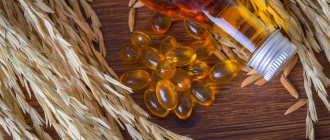

![Table 1. Comparison of the results of treatment with Tribestan for men with oligoasthenozoospermia [7] with mod.](https://ms-pi.ru/wp-content/uploads/tablica-1-sravnenie-rezultatov-lecheniya-tribestanom-muzhchin-s-oligoastenozoospermiej-7-330x140.jpg)

